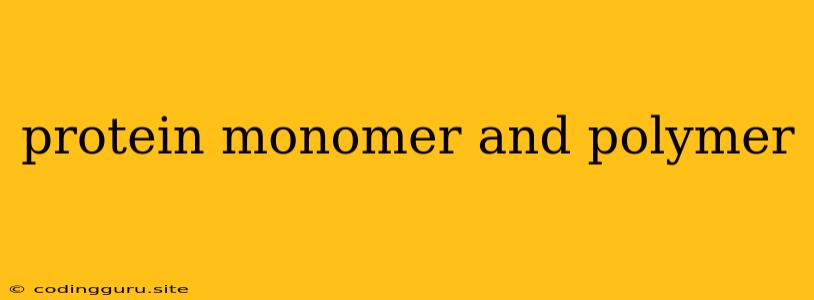The Building Blocks of Life: Protein Monomers and Polymers
Proteins are essential molecules that play a wide range of roles in living organisms. They are responsible for everything from transporting oxygen in our blood to catalyzing biochemical reactions within our cells. But how are these complex molecules constructed? The answer lies in the fundamental building blocks of proteins: protein monomers and polymers.
What are Protein Monomers?
Protein monomers, also known as amino acids, are the individual building blocks of proteins. There are 20 different types of amino acids that are commonly found in proteins. Each amino acid consists of a central carbon atom bonded to four different groups:
- An amino group (-NH2)
- A carboxyl group (-COOH)
- A hydrogen atom (-H)
- A side chain (R-group)
The R-group is what distinguishes one amino acid from another. Each R-group has unique chemical properties, which in turn influence the overall properties of the protein.
How are Protein Monomers Joined Together?
Protein monomers are linked together to form protein polymers through a process called dehydration synthesis. In this process, a water molecule is removed from two adjacent amino acids, forming a peptide bond. This bond connects the carboxyl group of one amino acid to the amino group of another amino acid.
What are Protein Polymers?
Protein polymers, also known as polypeptides, are chains of amino acids linked together by peptide bonds. These chains can range in length from a few amino acids to thousands of amino acids. The sequence of amino acids in a polypeptide chain is called the primary structure of the protein.
How Do Protein Polymers Fold into Functional Structures?
The primary structure of a protein determines its three-dimensional shape, which is crucial for its function. This shape arises from interactions between the amino acid side chains, leading to a hierarchy of structural levels:
1. Secondary Structure: This level of protein structure involves local folding patterns within the polypeptide chain. These patterns include alpha-helices and beta-sheets, which are stabilized by hydrogen bonds between the backbone atoms of the polypeptide chain.
2. Tertiary Structure: This level of structure refers to the overall three-dimensional shape of a single polypeptide chain. It is determined by interactions between the side chains of amino acids, including hydrogen bonds, ionic bonds, disulfide bridges, and hydrophobic interactions.
3. Quaternary Structure: Some proteins are composed of multiple polypeptide chains, called subunits. The arrangement of these subunits in space constitutes the quaternary structure.
The Importance of Protein Structure
The specific three-dimensional shape of a protein is essential for its function. Any change in the amino acid sequence, or even a small change in the environment, can alter the protein's shape and disrupt its function. This can lead to disease. For example, mutations in the gene encoding the protein hemoglobin can lead to sickle cell anemia.
Examples of Protein Monomers and Polymers
Here are some examples of protein monomers and protein polymers:
- Protein Monomers: Glycine, Alanine, Valine, Leucine, Isoleucine, Proline, Phenylalanine, Tryptophan, Methionine, Serine, Threonine, Cysteine, Tyrosine, Asparagine, Glutamine, Aspartic Acid, Glutamic Acid, Lysine, Arginine, Histidine.
- Protein Polymers: Insulin, Hemoglobin, Collagen, Antibodies, Enzymes
Conclusion
Protein monomers and protein polymers are the fundamental building blocks of proteins, essential molecules for life. Understanding the structure and function of these building blocks is crucial for understanding the complex mechanisms that govern living organisms.
